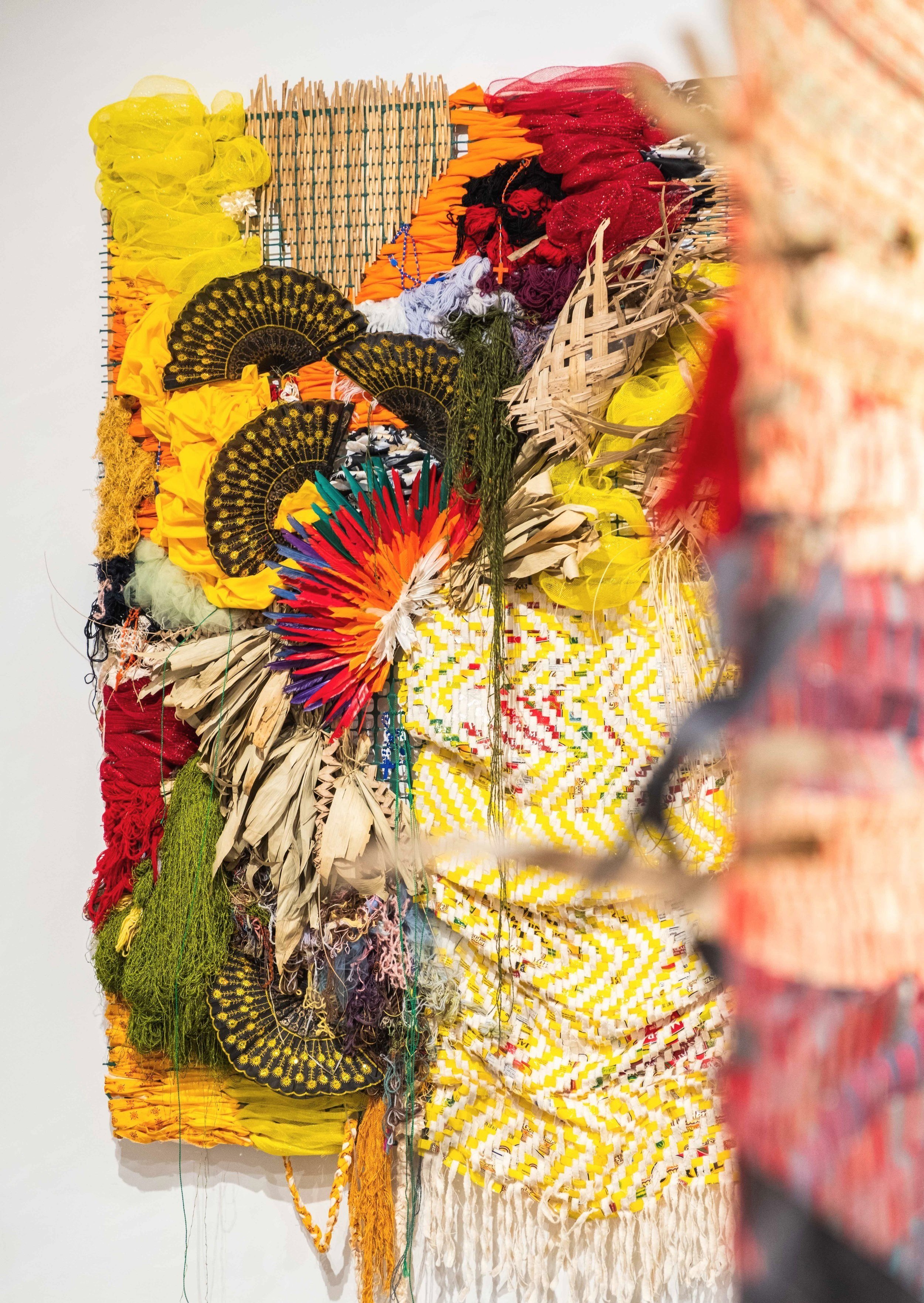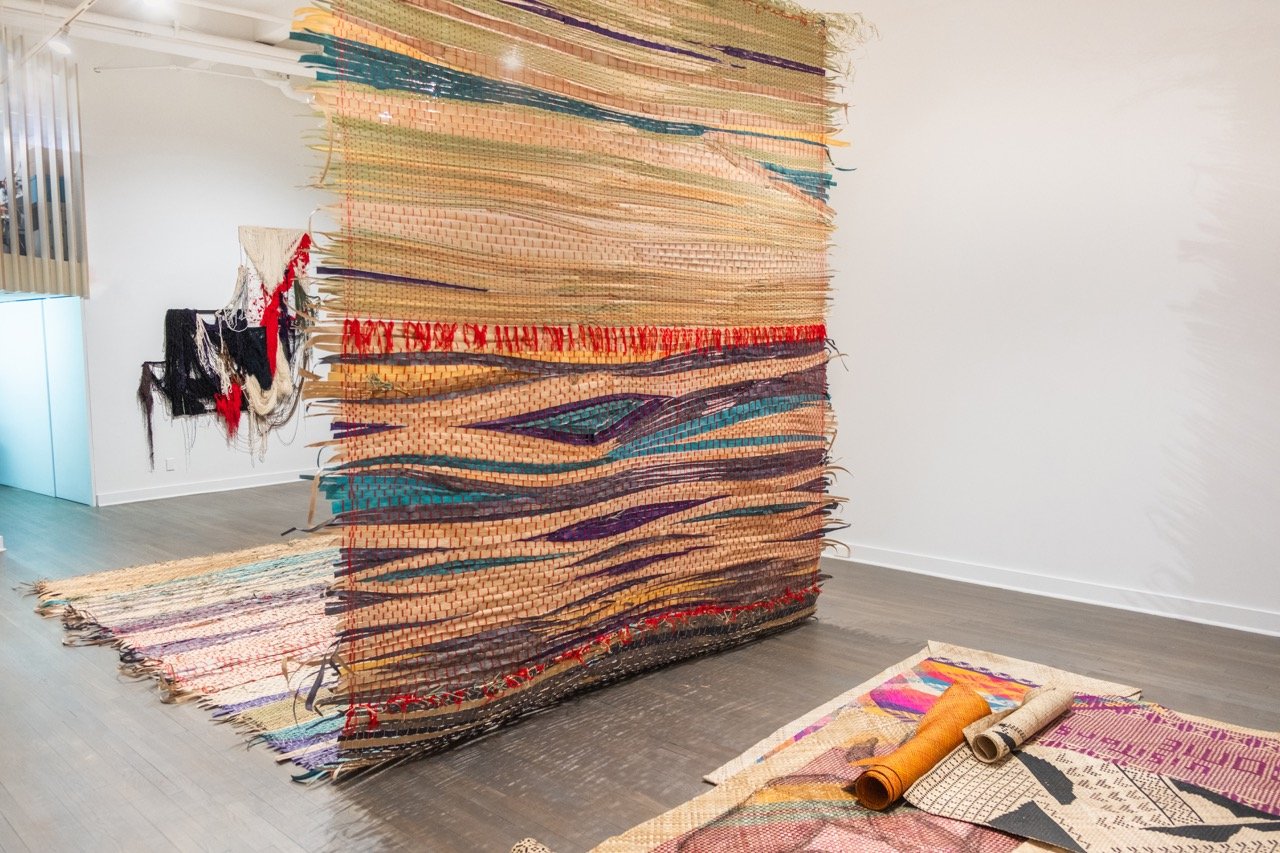Writer: Sasha Cordingley
Essay Mentor: Ana Tuazon
This essay was produced in conjunction with the exhibition Sometimes My Accent Slips Out by Bhen Alan, mentored by Jade Yumang with curatorial guidance from Jon Santos, and on view at CUE Art from April 4 – May 18, 2024. The text was commissioned as part of CUE’s Art Critic Mentorship Program, and is included in the free exhibition catalogue available at CUE and online.
Installation view of Sometimes My Accent Slips Out by Bhen Alan, 2024. Photo by Leo Ng.
When I ask Filipino artist Bhen Alan about the purpose of the banig, he offers an extensive list: it is a site for gossiping, eating, dance, and rest, he shares, and goes on to extol it as a vessel for life and death. His admiration for the hand-woven mat and its connection to the life cycle is understandable; its slick surface welcomed him—as it had many of his antecedents—in birth, and just two years afterward, the plaited fibers of the same banig were wrapped around his father’s body after he drowned in the village river.
Although most are familiar with the banig in the context of its domestic uses, its function as casket, midwife, or sacred grounds can be traced to the Philippines’ pre-colonial era, before the Spanish Empire arrived bearing rosary and cross, or the imperial arm of the United States instituted its own systems of education and governance. Antonio Pigafetta documented the banig in Primo viaggio intorno al mondo (1525), a personal chronicle of Ferdinand Magellan’s proselytizing voyage to the Philippines’ Visayan Islands in the 16th century. The scribe wrote, “When we came to the town we found the King of Zzubu [Cebu] at his palace, sitting on the ground on a mat made of palm, with many people about him.”¹ He recorded matrilineal customs, too: “[The women] do not work in the fields but stay in the house, weaving mats, baskets, and other things…from palm leaves.”² Even the queen partook in the laborious folding that characterizes the banig, and its indigenous applications traversed hierarchies and functions alike.
Installation view of Sometimes My Accent Slips Out by Bhen Alan, 2024. Photo by Leo Ng.
Despite its longevity, the banig has scarcely been documented in the manuals and archives of the Philippines’ material history. Alan tells me that it is a tradition passed directly from one weaver to another, transmitted through communities that are already attuned to the specific bends and splices of the palm, pandan, or tikog leaves that they employ. Techniques and designs are often held close—rarely leaving the boundaries of a barangay—for the simple fact that each community—and each weaver—retains distinct color schemes and pattern designs, ones that reflect local or personal narratives, ideologies, and beliefs. What they do share is the collective understanding that banig weaving does not start at the first fold of a reed over another, but with seeds that are sewn and tended to until harvest.
Many of these communities live in intimate relationship with the surrounding ecosystem, and tending to the land is an integral function of daily life. The Molbog people, for example, are nestled in the remote mountaintops of Balabac, Palawan; their isolated barangay lacks a cellular network, electricity, or access to clean water. Employment is scant. Yet, banig weaving persists as a viable source of income precisely because the community continually invests in the full life cycle of the pandan plant. For the Molbog, the banig is intimately entwined in a natural cycle of living and dying that is essential to human and nonhuman survival, wherein one cannot exist without the other; it is a stark contrast to the “destroy, extract, exploit” approach to the land’s resources in much of the West. Taken altogether, banig is not just an everyday object, but an emblem of Filipino identities—of people who have firmly resisted the steamrolling of culture, memory, and tradition by colonial enterprises.
Madapaka, 2022. Mixed media; 6 x 4 feet. Photo by Leo Ng.
Bhen Alan’s practice of abstracted sculptural banigs makes this explicit. Madapaka (2022) is a burst of tousled fabrics in dazzling yellow and orange, pockmarked by dehydrated palm leaves, knotted fibers of yarn, and a slew of embellished fans. A close look at the work reveals dangling rosaries impersonating strands of thread, hidden amongst the torrent of material. They may look like haphazard additions, but the shrouding of the sacrament alludes to the Spanish Empire’s wielding of Catholicism and so-called cultural enlightenment as a means of seizing land across the Philippines from 1565 onward. Surrounding the rosaries are a number of intricately detailed multi-colored fans. Alan tells me he used to be a folk dancer, and that fans are often used in the dances of his community as an extension of the arm, marking the limits of bodily movement through swift flicks and circumvolutions by the dancer. In the work, the fans protrude like the feathers of a peacock, amplifying its presence. Their use suggests a prevailing native body and the traditions it enacts, informed by colonial presence yet unwilling to be suppressed by its afterlife.
Mother Tongue (2023) unfurls from the ceiling and splays out like a mouth stretched open and seized mid-sentence. It is a scroll of bound horizontal palm and pandan leaves in sage, turquoise, red, beige, yellow, and purple, and its edges jut out in provocation. Lodged throughout the work are bushy patches of cattails gathered from the lakes of the artist’s adopted home in New England. They stand tall like weeds emerging from gravel, refusing to warp to the linear arrangement of the work’s principal textiles.
Installation view of Sometimes My Accent Slips Out by Bhen Alan, 2024. Photo by Leo Ng.
In our conversation, Alan tells me how his assimilation into North America is at times interrupted by his inability to fully assume the English language. Words dissipate upon recollection, and the intonations of his mother tongue inflect as he speaks. Rather than force the expected dialect of the region’s primary language, Alan indulges his linguistic ruptures by letting them linger, mis/translating them through the entropic composition of his banigs. He draws upon these dynamics of language in The Difference between P and F (2024), composed of bundles of tangled yarn that clump and droop across asymmetrically adjoined stretchers, and Filipino. Pilipino. (2022-24), in which coiled strips of rattan loop around and through each other against a gridded brace, as if tripping over tongue-twisters in a new language or grasping at tip-of-the-tongue recollections.
Particularly striking about this latter work is the artist’s use of whole sheets of woven rattan, which are found on many of the Philippines’ white sand beaches. Rattan is often woven by locals into chaise lounges, handbags, placemats, and coffee tables. The same is true for the banig; its forms and processes have taken on the shape of yoga mats, coasters, and sun hats by will of tourists seeking supposedly authentic souvenirs. Some communities in the archipelago have even lost their traditions of weaving as a direct result of the commodification of the craft. Although acutely aware of the onerous economic conditions that engender the banig as marketable product, Alan resists this outcome as the mat’s final form.
It is undeniable that much of the archipelago’s post-colonial culture today maintains remnants of the Spanish and American empires: there are basketball courts and churches in every barangay, and military bases aplenty. The banig, however, has endured. By foregrounding the woven mat in his practice, Alan reclaims the object as a tactile archive that has survived rounds of cultural erasure by colonial regimes, one that narrates stories not just of the artist, but of communities that for centuries have gossiped, eaten, danced, rested, lived, and died—all on the ubiquitous banig.
Installation view of Sometimes My Accent Slips Out by Bhen Alan, 2024. Photo by Leo Ng.
Endnotes
[1] Stanley, Henry Edward John, and Antonio Pigafetta. The first voyage round the world by Magellan. London: The Hakluyt Society, 1874. Sabin Americana: History of the Americas, 1500-1926.
[2] Ibid.
About the Writer
Sasha Cordingley (she/they) is an arts and culture writer from the Philippines, born in Hong Kong, and residing in Brooklyn, NY. She currently works as a Press Officer and Writer at the Studio Museum in Harlem. Her writing has been published in Hyperallergic, Art Papers, ArtAsiaPacific, C Magazine, The Strategist, and Dirt. She is the recipient of C Magazine’s New Critic Award and the Henry Moore Institute Dissertation Award.
About the Writing Mentor
Ana Tuazon is a writer and educator based in Brooklyn, New York. Her writing on art, culture, and collectivity has been published in print and online; most recently in Track Changes: A Handbook for Art Criticism (Paper Monument, 2023). She was an Andy Warhol Foundation Arts Writers grantee in 2021, and a 2019-21 Critical Studies Fellow in the Core Program at the Museum of Fine Arts, Houston. She currently teaches part-time at Parsons School of Design.
About the Art Critic Mentorship Program
This text was written as part of the Art Critic Mentorship Program, a partnership between CUE and the AICA-USA (the US section of International Association of Art Critics). The program pairs emerging writers with art critic mentors to produce original essays about the work of artists exhibiting at CUE. Learn more about the program here. No part of this essay may be reproduced without prior written consent from the author.





